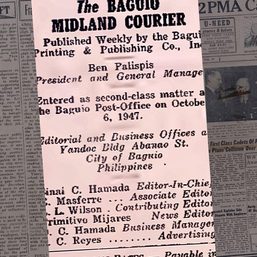SUMMARY
This is AI generated summarization, which may have errors. For context, always refer to the full article.
![[OPINION] Never again, never forget: The violent memory of Martial Law](https://www.rappler.com/tachyon/2022/09/Never-again-never-forget-violent-memory-of-Martial-Law.jpg)
September marks the anniversary of a turbulent, violent, and painful memory in Philippine history – Ferdinand E. Marcos’ Martial Law. This year, in particular, denotes the 50th anniversary of its declaration.
“Never again, never forget,” we chant to remember, to commemorate, to fight.
But for those of us who weren’t alive during the time, pro-Marcos Filipinos always throw the argument, “’Di pa naman kayo pinapanganak nun, paano ‘nyo alam?” (You weren’t born then so how do you know?)
And as retaliated by many, the younger generation’s memory of Martial Law comes from different sources, like their family’s personal stories, lessons taught in history class, artworks based on or made during the time period, news clippings from media outlets. The memory of something does not need to be experienced firsthand for people to express empathy and solidarity.
And so, based on various sources, here is why we must not forget.
Marcos started his political career in 1949 as a congressman in Ilocos Norte. He became a senator in 1959 and finally, the president in 1965. When he ran for president, he campaigned with his wife, the “endearing” Imelda Marcos. Imelda, as a beauty queen who sang for the crowd, was a vote-getter. They campaigned together which earned them patronage from the people. It’s not difficult to see why the Filipinos loved them – aside from Marcos being from the north and Imelda being from the Visayas – they were seen as a couple, a love team people could root for. To be a little blasphemous about it, they can be juxtaposed with KathNiel, AlDub, LizQuen or JaDine.
However, Ferdie and Imelda’s identities went beyond this swooning couple, and beyond the praise that people gave them. Firstly, Marcos’ character was questionable. He presented himself as the country’s “most decorated war hero” but this was proven to be untrue. To have most of his appeal come from a lie is already questionable. In addition to this, during the 1986 snap elections, vote tabulators from the Commission on Elections or Comelec walked out as they noticed superiors manipulating the vote count to put Marcos in the lead. This packs on the deceit that Marcos upheld as a leader. What do we expect from a president who repressed the media so that his failures and atrocities remain unknown anyway?
Corruption and human rights during Martial Law
Aside from mere lies, Primitivo Mijares wrote in his book, The Conjugal Dictatorship of Ferdinand and Imelda Marcos, “The corruption of the martial regime is not confined to the insatiable acquisition of the country’s material resources, but extends to the exercise of power itself. Having proclaimed martial law, he proceeded to bribe, coerce and/or intimidate the Constitutional Convention members into drafting a new charter dictated by him.” Aside from corruption of funds and resources, Marcos’ propagandist-turned-whistleblower Mijares confirmed the late dictator’s greed for power. He didn’t want his term to end which led to the declaration of Martial Law.
However, as terrible as this already sounds, from lies to theft to repression to corruption, the history of Martial Law gets worse as we dig deeper. While corruption ensued, media was repressed, cronies were favored, lies were propagated, shoes were collected, Filipinos’ human rights were also being directly violated.
According to an Amnesty International report that documents the human rights abuses during Martial Law, there are around 3,240 known extrajudicial killings, 34,000 documented tortures, 70,000 imprisonments, and 77 recorded disappearances. It’s important to note that these are just the recognized ones, meaning that the numbers are even higher when we consider the cases that went unrecorded. With these large statistics, we must remind ourselves that Martial Law victims are more than just numbers. These are fellow Filipinos, most of them political rivals, student activists, journalists, religious workers, farmers, peasant organizers; most of them fought the dictator.
The Marcoses’ corrupt desire for power led to all of this. To make it even more concrete, Mijares himself, who used to be Marcos’ most trusted confidante, was one of the victims. After turning against the Marcoses, he disappeared and was never found, while his son, Luis Manuel Mijares, was killed shortly after. They are just two of the thousands of victims who were either killed or who continue to be scarred by their past.
Sources of a collective memory
Many works continue to record this history of human rights abuses during Martial Law, not just through documents but also through art. Desaparesidos, a novel by Lualhati Bautista, chronicles the experience of a desaparecido, who was tortured and eventually incarcerated. It follows the life of a mother who finds it hard to move past the pain brought by Marcos’ Martial Law. Liway, a film by Kip Oebanda, shows a family who spent years in prison together because they fought against the Marcoses. ML, a film by Benedict Mique, depicts the level of brutality of the state force during Martial Law. Indigo Child, a play by Rody Vera, shows the scars that remain even years after a victim is tortured and how this can cause rifts in the family.
These are just a few examples and sources to get started with, which already show that we do not need to have been there to stand against the untruths and injustices. But after hearing how atrocious, violent, and scarring Martial Law is, why must we never forget? Would it not be easier if we did?
There are numerous victims who continue to find it hard to recount their experiences, and this is completely understandable. We should not dictate on individuals who have been abused and violated in unimaginable ways on how to deal with their trauma. However, collectively as a Filipino people, in solidarity with all the victims who choose to continue to speak out or can’t, we must never forget. We must never forget because it is disrespect for those who fought so that we may be free from the clutches of the Marcos dictatorship. To remember is to memorialize those who sacrificed their safety and personal lives so that future generations would not suffer what they did.
It even becomes more imperative that we remember, especially now that disinformation, historical denialism, and the Marcosian myth persist. It becomes more important now that the son of the dictator again sits, sleeps, lives in, and has invaded Malacañang Palace.
We must never forget so that we may never again suffer the same fate. Ironically, they are back at the Palace, which reminds us to fight again, to continue remembering, and to speak the truth.
We find ourselves again at the precipice of history. What do we do now? Never again. Never forget. – Rappler.com
Tony La Viña teaches law and is former dean of the Ateneo School of Government. Bernardine de Belen recently graduated from the Ateneo de Manila University with a Creative Writing degree. She has just joined Manila Observatory as a research assistant.
Add a comment
How does this make you feel?
![[Closer Look] ‘Join Marcos, avert Duterte’ and the danger of expediency](https://www.rappler.com/tachyon/2024/06/TL-trillanes-duterte-expediency-june-29-2024.jpg?resize=257%2C257&crop_strategy=attention)

![[Newspoint] A Freedom Week joke](https://www.rappler.com/tachyon/2024/06/20240614-Filipino-Week-joke-1.jpg?resize=257%2C257&crop_strategy=attention)


![[Hindi ito Marites] First Lady Liza Marcos: Unofficial presidential spokesperson?](https://www.rappler.com/tachyon/2024/05/Hindi-ito-Marites-TC-ls-02.jpg?resize=257%2C257&crop_strategy=attention)




There are no comments yet. Add your comment to start the conversation.